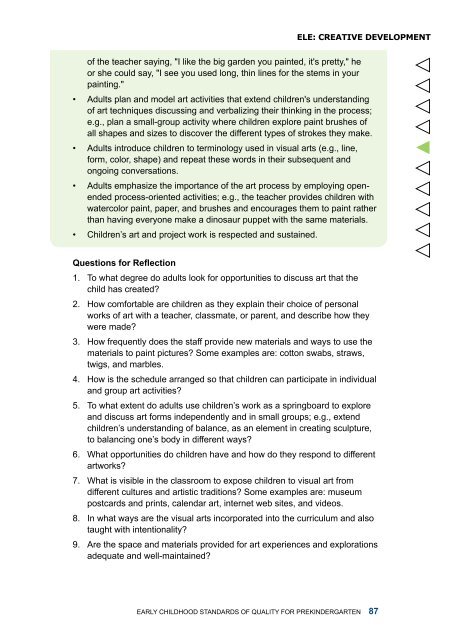Early Childhood Standards of Quality for ... - State of Michigan
Early Childhood Standards of Quality for ... - State of Michigan
Early Childhood Standards of Quality for ... - State of Michigan
Create successful ePaper yourself
Turn your PDF publications into a flip-book with our unique Google optimized e-Paper software.
ELE: Creative Development<strong>of</strong> the teacher saying, "I like the big garden you painted, it's pretty," heor she could say, "I see you used long, thin lines <strong>for</strong> the stems in yourpainting."• Adults plan and model art activities that extend children's understanding<strong>of</strong> art techniques discussing and verbalizing their thinking in the process;e.g., plan a small-group activity where children explore paint brushes <strong>of</strong>all shapes and sizes to discover the different types <strong>of</strong> strokes they make.• Adults introduce children to terminology used in visual arts (e.g., line,<strong>for</strong>m, color, shape) and repeat these words in their subsequent andongoing conversations.• Adults emphasize the importance <strong>of</strong> the art process by employing openendedprocess-oriented activities; e.g., the teacher provides children withwatercolor paint, paper, and brushes and encourages them to paint ratherthan having everyone make a dinosaur puppet with the same materials.• Children’s art and project work is respected and sustained.Questions <strong>for</strong> Reflection1. To what degree do adults look <strong>for</strong> opportunities to discuss art that thechild has created?2. How com<strong>for</strong>table are children as they explain their choice <strong>of</strong> personalworks <strong>of</strong> art with a teacher, classmate, or parent, and describe how theywere made?3. How frequently does the staff provide new materials and ways to use thematerials to paint pictures? Some examples are: cotton swabs, straws,twigs, and marbles.4. How is the schedule arranged so that children can participate in individualand group art activities?5. To what extent do adults use children’s work as a springboard to exploreand discuss art <strong>for</strong>ms independently and in small groups; e.g., extendchildren’s understanding <strong>of</strong> balance, as an element in creating sculpture,to balancing one’s body in different ways?6. What opportunities do children have and how do they respond to differentartworks?7. What is visible in the classroom to expose children to visual art fromdifferent cultures and artistic traditions? Some examples are: museumpostcards and prints, calendar art, internet web sites, and videos.8. In what ways are the visual arts incorporated into the curriculum and alsotaught with intentionality?9. Are the space and materials provided <strong>for</strong> art experiences and explorationsadequate and well-maintained?<strong>Early</strong> <strong>Childhood</strong> <strong>Standards</strong> <strong>of</strong> <strong>Quality</strong> <strong>for</strong> Prekindergarten 87


